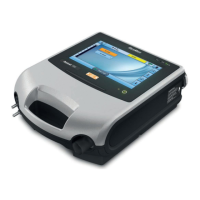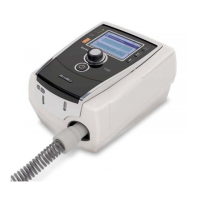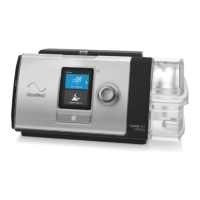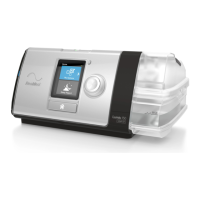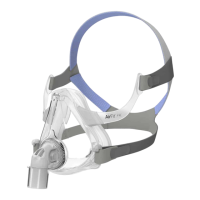Do you have a question about the ResMed Astral 100 Series and is the answer not in the manual?
Provides continuous or intermittent ventilatory support for patients weighing > 5 kg for invasive/non-invasive use.
Lists conditions where the device should not be used, e.g., pneumothorax, dehydration.
Lists potential side effects like dry nose/mouth, headache, skin rashes.
Provides critical safety information and precautions for device use.
Describes the components and features of the Astral device.
Explains interaction via the touch screen and its changing display.
Displays operating status, patient type, circuit, programs, alarms, and power.
Provides access to Monitors, Setup, Alarms, and Information menus.
Displays Stop/Start ventilation and Apply/Cancel functions.
Displays monitoring data, controls, and real-time therapy pressure.
Recommends performing a functional test before starting therapy.
Step-by-step guide to power the device on and off safely.
Describes 'Big button mode' for easier usability and accessibility.
Step-by-step guide to start and stop ventilation.
Overview of accessing the four main menus and their sub-menus.
View real-time patient data in waveform or monitoring formats.
Access to setup configurations and alarm settings.
Details configurable settings and how to adjust them.
Explains how clinicians configure programs for different treatment options.
Details on delivering manual breaths and sigh breaths.
Safety and packing guidelines for travelling with the device.
Details circuit types and suitable patient settings.
Step-by-step guide to fitting the correct circuit adapter.
Instructions for connecting single limb circuits with leak or valve.
Instructions for connecting a single limb circuit for invasive ventilation.
Guide to connecting a single limb circuit with an integrated expiratory valve.
How to connect a double limb circuit for the Astral 150.
Function to determine circuit characteristics and perform a device self-test.
Lists and describes power accessories like external battery and power station.
Instructions for attaching a humidifier or HME.
Instructions and warnings for attaching an antibacterial filter.
How to add supplemental oxygen up to 30 L/min.
How to connect a pulse oximeter and view readings.
Connecting the ResMed Remote Alarm II for audible/visual alerts.
Steps to connect the device to mains AC power.
How to connect external batteries for extended power.
Information on the internal battery's operation and limitations.
How to connect an external DC power source.
Instructions for using the Astral Carry Bag.
Shows alarm messages and the full list of active alarms.
Temporarily mute audible alerts or pre-silence expected alarms.
Procedure to remove alarms from display and turn off alerts.
How to test the alarm sounders and indicators.
Describes power alarms and how to test the remote alarm.
How the Disconnection Alarm detects disconnection.
How clinicians can adjust Activation Time and Tolerance.
Steps to transfer data from the device to ResScan software via USB.
Warning about authorized service and repair.
Instructions for removing and replacing the air filter.
Schedule for recommended service intervals and tasks.
Common reasons for alarms and troubleshooting steps.
Troubleshooting steps for Learn Circuit errors and codes.
Troubleshooting for common issues like condensation, screen issues, USB.
Specifies pressure limits and circuit resistance/compliance ranges.
Device compliance with EMC standards and emissions guidance.
Information on EMC immunity and guidance.
Explanation of symbols and list of standards the device meets.
Details warranty periods for different product components.
Defines various ventilation settings available on the device.
Explains measured and calculated parameters displayed during configuration or ventilation.
Provides continuous or intermittent ventilatory support for patients weighing > 5 kg for invasive/non-invasive use.
Lists conditions where the device should not be used, e.g., pneumothorax, dehydration.
Lists potential side effects like dry nose/mouth, headache, skin rashes.
Provides critical safety information and precautions for device use.
Describes the components and features of the Astral device.
Explains interaction via the touch screen and its changing display.
Displays operating status, patient type, circuit, programs, alarms, and power.
Provides access to Monitors, Setup, Alarms, and Information menus.
Displays Stop/Start ventilation and Apply/Cancel functions.
Displays monitoring data, controls, and real-time therapy pressure.
Recommends performing a functional test before starting therapy.
Step-by-step guide to power the device on and off safely.
Describes 'Big button mode' for easier usability and accessibility.
Step-by-step guide to start and stop ventilation.
Overview of accessing the four main menus and their sub-menus.
View real-time patient data in waveform or monitoring formats.
Access to setup configurations and alarm settings.
Details configurable settings and how to adjust them.
Explains how clinicians configure programs for different treatment options.
Details on delivering manual breaths and sigh breaths.
Safety and packing guidelines for travelling with the device.
Details circuit types and suitable patient settings.
Step-by-step guide to fitting the correct circuit adapter.
Instructions for connecting single limb circuits with leak or valve.
Instructions for connecting a single limb circuit for invasive ventilation.
Guide to connecting a single limb circuit with an integrated expiratory valve.
How to connect a double limb circuit for the Astral 150.
Function to determine circuit characteristics and perform a device self-test.
Lists and describes power accessories like external battery and power station.
Instructions for attaching a humidifier or HME.
Instructions and warnings for attaching an antibacterial filter.
How to add supplemental oxygen up to 30 L/min.
How to connect a pulse oximeter and view readings.
Connecting the ResMed Remote Alarm II for audible/visual alerts.
Steps to connect the device to mains AC power.
How to connect external batteries for extended power.
Information on the internal battery's operation and limitations.
How to connect an external DC power source.
Instructions for using the Astral Carry Bag.
Shows alarm messages and the full list of active alarms.
Temporarily mute audible alerts or pre-silence expected alarms.
Procedure to remove alarms from display and turn off alerts.
How to test the alarm sounders and indicators.
Describes power alarms and how to test the remote alarm.
How the Disconnection Alarm detects disconnection.
How clinicians can adjust Activation Time and Tolerance.
Steps to transfer data from the device to ResScan software via USB.
Warning about authorized service and repair.
Instructions for removing and replacing the air filter.
Schedule for recommended service intervals and tasks.
Common reasons for alarms and troubleshooting steps.
Troubleshooting steps for Learn Circuit errors and codes.
Troubleshooting for common issues like condensation, screen issues, USB.
Specifies pressure limits and circuit resistance/compliance ranges.
Device compliance with EMC standards and emissions guidance.
Information on EMC immunity and guidance.
Explanation of symbols and list of standards the device meets.
Details warranty periods for different product components.
Defines various ventilation settings available on the device.
Explains measured and calculated parameters displayed during configuration or ventilation.
| Device Type | Portable Ventilator |
|---|---|
| Max Pressure | 60 cm H2O |
| Operating Temperature | 5°C to 40°C (41°F to 104°F) |
| Operating Humidity | 10% to 95% relative humidity, non-condensing |
| Display | Color LCD touchscreen |
| Modes of Ventilation | CPAP |
| Data Storage | SD card |
| Alarms | Adjustable visual and audible alarms |
| Tidal Volume | 50 to 2500 mL |
| Inspiratory Time | 0.3 – 5 seconds |
| FiO2 Monitoring | Yes |
| Power Supply | AC 100 – 240V, 50/60 Hz |
| Oxygen Compatibility | Yes |
| Pressure Range | 4 – 60 cm H2O |
| PEEP | 4 to 25 cm H2O |
